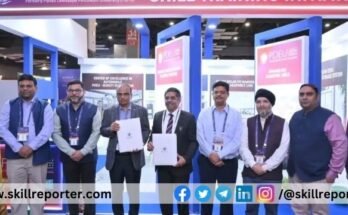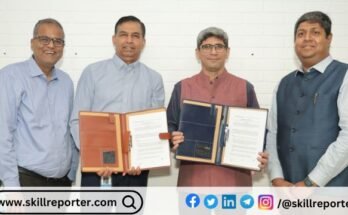The National Skill Development Corporation (NSDC) is a public private partnership under the ambit of Ministry of Skill Development and Entrepreneurship (MSDE) set up as part of the governments’ coordinated action in the skills space with the specific target of skilling /up skilling 160 million people by 2022. NSDC operates in this area by partnering with Training Partners (TPs), Sector Skill Sector Councils (SSCs).
NSDC intends to select an agency to conduct an evaluation of the interventions under government/ funded flagship skill development programs. The evaluation will focus on candidates at different stages of the skilling lifecycle, right from enrolment to placement. Baseline, concurrent or periodic and end-line surveys will be conducted. The evaluation is intended to aid decision makers in taking decisions regarding different types of skilling interventions being provided to target segments under the scheme.
Objective
NSDC intends to select an agency to conduct a concurrent evaluation of the three types of interventions under the flagship skill training program – Short-Term Trainings (STT), Recognition of Prior Learning (RPL) and Special Projects (SP).
This proposed evaluation method will assess sectoral and cross-sectional performance of the skilling interventions across India, with respect to performance indicators related to access, equity, learning outcomes, innovation, employability, innovation-based entrepreneurship etc. In addition, this study will evaluate relevance, efficiency and effectiveness of skill training program in a periodic manner.
Scope Of Work
- Methodology:
Major intervention areas of the scheme include fresh skilling, reskilling, upskilling, formalization of prior learning, and targeted interventions requiring flexibility. The proposed concurrent evaluation will cover all the states/ UTs/ districts and training providers implementing the flagship skilling program.
The study will focus on evaluating impact of the program on the individual, and at the enterprise and society/ economy level. In order to attain the objectives, the evaluation proposes to cover both, the Training Centre (TC), to assess efficiency and performance of TCs, and candidate, to assess effectiveness and impact of the training program in terms of their perspective of the program, learning outcomes, innovation, employability, innovation-based entrepreneurship etc. Additionally, the study will assess the impact on employers/ enterprises of hiring individuals skilled under the program. It will also focus on impact at a societal level and on the wider labour market and economy.
In this context this framework proposes an evaluation strategy that synthesises multiple evaluation methodologies and which can be used to improve both implementation and outcomes, i.e., concurrent evaluation method. The evaluation method will be divided into three stages – Baseline, Midline and End line. - Evaluation framework:
Concurrent evaluation serves both objectives of evaluation – lesson-learning and accountability. A properly designed evaluation can answer the question of whether the program is working or not, and its impact, and hence assist in decisions about scaling up and strengthen accountability.
The proposed concurrent evaluation method will follow a quasi-experimental matching design using
mixed research approach – quantitative and qualitative assessment along with in-depth research, analysis, and inquiry.
The quantitative assessment will be designed as a series of surveys to assess the outreach of skill training program and impact of the programme on the enhancement of skills. The qualitative part of this evaluation will be designed to cover the nature and scope of participatory evaluation, which will be implemented through concurrent qualitative data collection. Additionally, operations research and cost-effectiveness analysis will be carried out to provide additional evidence that help in reaching the intended goals of strengthening project performance during implementation. The entire evaluation framework will be designed based on criteria as per the OECD/DAC criteria and the United Nations Evaluation Group (UNEG) guidelines, as given in the below schematic. - Sample and Analytical framework:
- The evaluation will cover all districts across all states/ UTs where the scheme is implemented through a systematic sample.
- Sample of candidates will be selected using stratified sampling approach and sample will be distributed across skilling lifecycle i.e., enrollment/ training/ assessment/ certification/
placement. - A total sample of 5% of trained candidates will be selected from each district in each phase of survey (with a maximum of 600 candidates and a minimum of 40 candidates wherever available).
However, a minimum of 4 samples (wherever available) will be selected from each identified sector where training has occurred. A higher sampling fraction is allotted to select beneficiaries where availability of beneficiaries is low. - The allotted number of beneficiaries in each stratum is selected independently. A systematic random sampling will be adopted for the selection of beneficiaries (like PPS or snowball sampling). To get the overall impact of the schemes in the district, weighted averages may work
out. - The methods will be adopted for impact analysis to consider observed changes in the income and the employment of the beneficiaries viz pre-post (before – and – after comparison).
- Simple comparison (treatment and control group, i.e. between beneficiaries and non-beneficiaries or Certified / Placed Candidate / beneficiaries and initial Enrolled Candidates)
- Difference in different (treatment and control group)
- Apart from observing the changes in the outcomes of income and employment, demographic and qualitative information will also be collected from the beneficiaries to obtain the profiles of the beneficiaries covered and the changes if any.
- Difference-in-difference (DD) method can be consider evaluating the impact that compares the changes in outcomes over time between the treatment group (i.e. beneficiaries /candidate whose training is ongoing/ completed) and the comparison group-I (beneficiaries who are trained and certified). Changes in income and employment pattern will also be observed with comparison group-II (those who have never received training under the scheme).
- A valid comparison (control) group should have the same characteristics as the group of beneficiaries of the skill training program (treatment group), except that the units in the
comparison group do not get benefit from the program. Comparison groups are used to estimate the counterfactual. - Other stakeholders to be covered in the primary research include Training Providers, Industry
Associations and Employers, Academicians / Subject Matter Experts, Central and State Ministry Officials, DSDP, SSCs.
Technical Proposal and Financial proposal Format and Content
- The Technical Proposal shall be prepared using the format provided in Annexure 1 of the RFP
- The Financial Proposal shall be prepared using the format provided in Form Fin 1 of the RFP. It shall list all costs associated with the assignment.
- The Technical Proposals and Financial Proposals shall be filled up and shared as single proposal.
- Only those proposals which qualify on all parameters of Eligibility criteria in point 5 above will be considered for evaluation.
- The Consultant is responsible for meeting all tax liabilities arising out of the Contract.
- The Consultant shall express the price for its Services in INR.
Submission of Proposal
- The Consultant shall submit a signed and complete Proposal comprising the documents and forms in accordance with Annexure 1. The Consultant shall submit Technical and Financial Proposal only on eProcurement Portal https://nsdc.eproc.in as per process mentioned in Annexure.
- An authorized representative of the Consultant shall sign the original submission letters in the required format for Technical Proposal and shall initial all pages. The authorization shall be in the form of a written power of attorney attached to the Technical Proposal.
- Any modifications, revisions, interlineations, erasures, or overwriting shall be valid only if they are signed or initialed by the person signing the Proposal.
Mode of Selection: Quality-and-Cost Based Selection (QCBS)
Last Date for Submission: 15 February 2023, 06:00 PM IST



